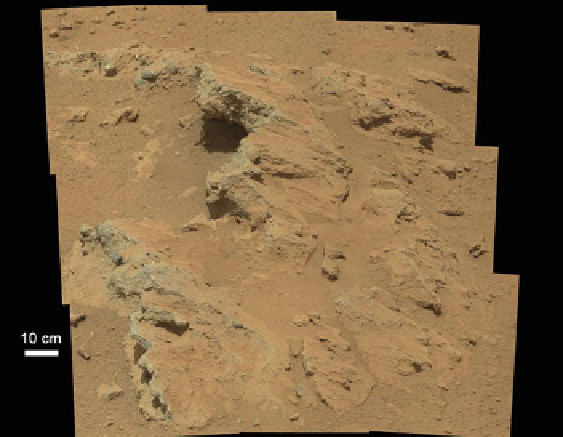Geoscience Reference
In-Depth Information
Fig. 8.18
“Hottah” rock outcrop - an ancient liquid water streambed discovered by the Curios-
ity rover team (3D version)
(
http://mars.jpl.nasa.gov/msl/multimedia/images/?ImageID=4722
-
NASA/JPL-Caltech, September 14, 2012)
deep. These rocks were found at the foot of an alluvial fan system descending from
the crater wall, which had previously been identified from the orbit (Various
2014
)
(Figs.
8.18
,
8.19
,and
8.20
).
On October 2012, the first X-ray diffraction analysis of a Martian soil was
performed by Curiosity. The results revealed the presence of several minerals,
including feldspar, pyroxenes, and olivine, and suggested that the Martian soil in
the sample was similar to the weathered basaltic soils of Hawaiian volcanoes. The
sample used is composed of dust distributed from global dust storms and local fine
sand. So far, the materials Curiosity has analyzed are consistent with the initial
ideas of deposits in Gale Crater recording a transition through time from a wet to
dry environment.
On December 2012, NASA reported that Curiosity performed its first extensive
soil analysis, revealing the presence of water molecules, sulfur, and chlorine in the
Martian soil. And on March 2013, NASA reported evidence of mineral hydration,
likely hydrated calcium sulfate, in several rock samples including the broken
fragments of “Tintina” rock and “Sutton Inlier” rock as well as in veins and nodules
in other rocks like “Knorr” rock and “Wernicke” rock. Analysis using the rover's
DAN instrument provided evidence of subsurface water, amounting to as much as
4 % water content, down to a depth of 60 cm (2.0 ft), in the rover's traverse from the
Bradbury landing site to the Yellowknife Bay area in the Glenelg terrain (Various
2014
)(Fig.
8.21
).

Search WWH ::

Custom Search